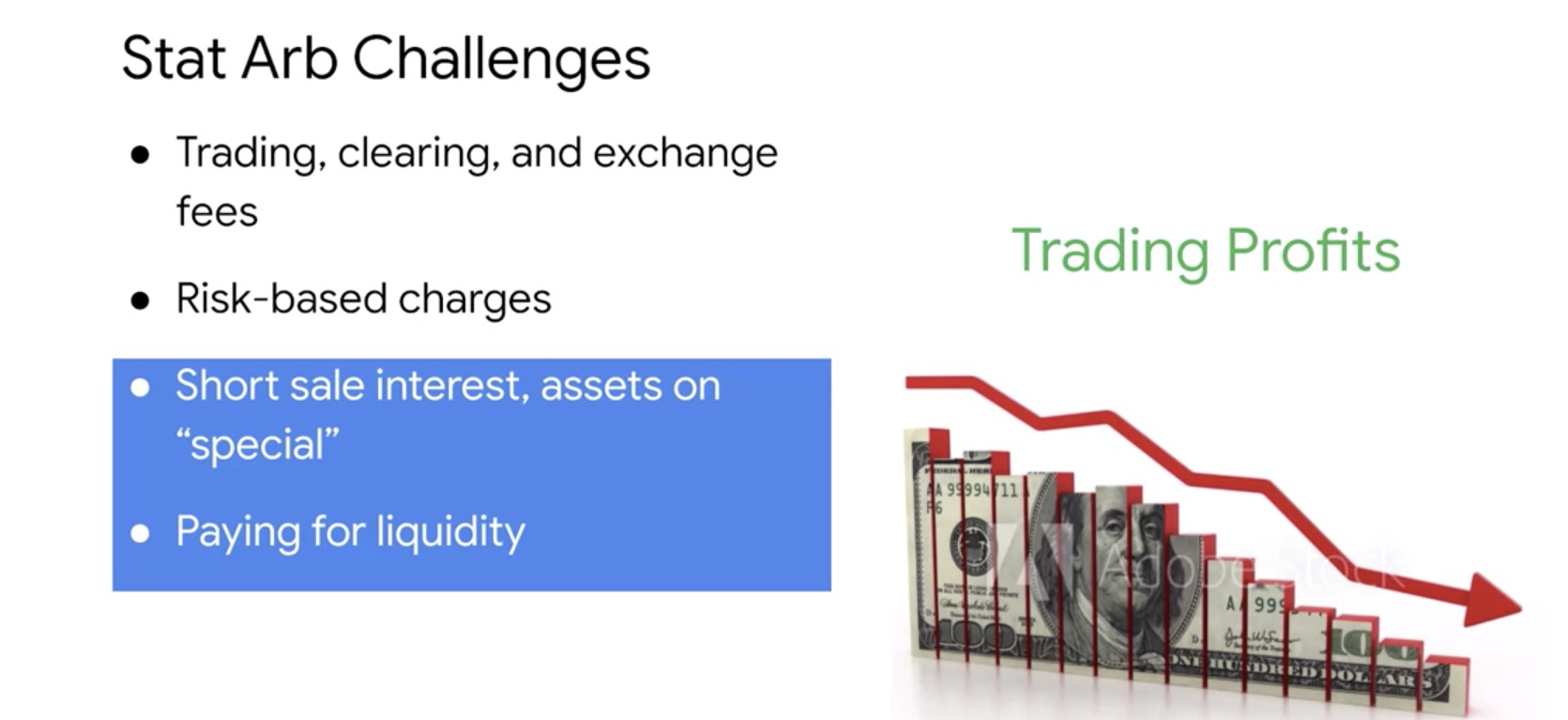统计套利的机遇和挑战
Next, we will look at some of the practical issues
and opportunities that Stat Arb traders face.
Stat Arb is very competitive and it’s hard for new entrants to compete in areas like index arbitrage especially in major markets. Fortunately, there are lots of opportunities in smaller markets and less liquid stocks and other assets(在规模较小的、流动性较差的股票和其他资产中有很多机会). These markets are less efficient, and so they offer more opportunities to trade profitably but on a smaller scale(这些市场效率较低,因此他们提供了很多机会以营利的模式进行交易,但是这些量很小).
Stat Arb profits are eaten away by a range of costs including trading, clearing(结算), and exchange fees(交易费用).
These are especially heavy for high-frequency traders. There are also risk-based charges which
factor in the cost of trading capital being tied up in collateral and margin for derivatives positions in short sales. Added to this are the cost to borrow assets for short sales, especially when there’s very high demand and limited supply as is the case when several hedge funds decide to short the same stock of a closely held company. Think Beyond Meat or Lyft. This is referred to as the asset being on special,
where the stock lender charges you as much as 60 percent to borrow the stock. This means you put up collateral of $100 and receive $40 back at the end of the year. 
Obviously, this is not a good strategy for more than a few weeks. Lastly, there’s a market impact cost of trading. Lower frequency arbitrators usually sell at the bid price and they buy at the ask price.
So they lose about half of that bid-ask spread on each transaction. This is paying for liquidity or being a liquidity taker rather than a liquidity provider such as a market-making firm. Arb trading firms consume lots of data. Initially, a firm must purchase and cleanse historical data that it will use as the input to models and strategies. Market feeds vary in price depending on the level of detail needed by the firm.
Daily open, high-low, and closed data is essentially free. High frequency data is more costly, but is essential for most quantitative strategies. High-frequency traders also need to have full visibility into
each asset’s order book and tick by tick data on the timing and size of transactions.
This type of feed can be quite expensive, especially if a firm trades in several markets at the same time.
Remember my earlier observation that the most promising areas for traders were smaller, less liquid stocks and markets? This comes with a big caveat.
In order to profit from these stocks, you need to actually be able to trade them. The reality is that liquidity is heavily concentrated in the largest cap stocks in the largest markets.
This is part of why these markets offer fewer mispricings and other inefficiencies.
When you design a trading strategy, you need to take into account how much trading actually takes place in the stock and what size of bid-ask spreads you will face if you decide to transact.
These hurdles can make an otherwise profitable strategy. You’re unexecutable or unprofitable.
Another challenge is it’s sometimes hard to borrow certain stocks. Recall our discussion of stocks being on special.
In this case, you may not be able to find a stock lender when you want to shorten them.
Also trading in stock may be halted due to pending news or simply because the market is not open.
This can cause you to lose a lot of potential profit from a strategy.
In our earlier example of spread trading of pair stocks, we had to wait a long time before the spread reached a level where we can sell it, and then another long time before it reached a level where we can buy it back again(在我们前面的配对股票价差交易的例子中,我们必须等待很长一段时间才能达到我们可以卖出的水平,然后再等很长一段时间才能达到我们可以再次回购的水平。).
During these waiting periods, correlations can change dramatically due to new information or events in the market. The longer your time frame, the more sensitive your trade is to these risks. This type of risk is generally not an issue for high-frequency traders who focus on ultra-short time frames. Instead, they have to worry about covering high trading costs with frequent but usually small profits. One of the most important things you need to keep in mind as you develop strategies is that when you trade a correlation or a spread, you can also change the market you’re trading in.
Prices will change immediately and other traders may withdraw liquidity(提取流动资金) if they sense a spread is being traded more heavily in one direction. They may also be able to figure out your strategy even if your trades are anonymous by noticing changes in price patterns in a asymmetries in the order book(他们也可以通过关注到订单中不对称的价格模式的变化,来确定你的策略,即使你的交易是匿名的。).
Ultimately, if your trades are large enough or persistent enough, they will eventually eliminate the profitability of the correlation or inefficiency(最终,如果你的交易足够大或足够持久,它们最终将消除相关性或低效率的盈利能力。). This is especially true when other terms start trading the same strategy.

